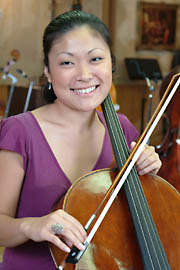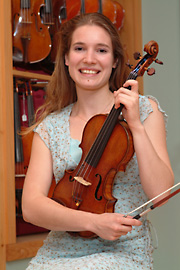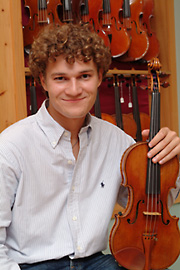Stradivarius on Stage by Jean-Sébastien Gascon
/ June 5, 2004
Version française...
 |
Kori Yamagami
Photo : Derek
Olivier | For most
string players, the only way to get one's hands on a genuine instrument from the
workshops of Stradivari, Guarneri, Rogeri or Montagnana is to win the lottery or
rob a museum--or perhaps to find one in a dumpster, as a Los Angeles nurse did
recently. But for some
privileged musicians, the Canada Council opens up the vaults of its Musical
Instrument Bank and loans out some of the finest instruments the world has ever
known. To be one of the lucky few, you first have to make a name for yourself.
Then you have to win a contest against other, equally distinguished virtuosi. If
you make it past that final stage, you have two or three years in which to play
your best on the instrument--then back it goes to the bank. The total value of
instruments on loan has reached $15 m, all of which is financed by grants or
private donations. No government funds are involved.
The public will be able to judge for themselves the
sound quality of these instruments during an exceptional event this summer: four
Stradivarius masterpieces will be reunited on one stage during the Montreal
Chamber Music Festival. Besides the chance to hear these great instruments live,
the event will include some fine examples of modern violin making, as compiled
by Tom Wilder at the invitation of Denis Brott. This will be a marvelous
opportunity to compare their sound with some classic works of Italian
craftsmanship.*
This year, the festival celebrates the 20th
anniversary of the Musical Instrument Bank's founding. Denis Brott, the
festival's creator, also played a large part in the project. As he explains it,
the essential goal was to allow musicians to perform on instruments that matched
their level of skill. When it comes time to record in the studio or perform in a
large concert hall, exceptional players are at a real disadvantage, artistically
speaking, if they cannot make use of exceptional instruments.
Denis
Brott spent 11 years helping to get the Musical Instrument Bank on its feet. His
dedication to this cause was partly a matter of necessity
 |
Hermine Gagné
Photo : Stéphanie
Lake |
and partly a matter of inspiration. When he was first given
a chance to play a period instrument, the effect was decisive. "The 1706 David
Tecchler cello has made an enormous difference in my life," he says. "Having a
voice that responds to every ounce of effort, that knows no limitations but my
own, leaves a wider door open for future personal development and growth. It is
an indescribable experience to produce a sound on this instrument."
An overview of the musicians and instruments
featured at the Montreal Chamber Music Festival's "Stradivarius on stage"
event
The 1696 Bonjour Stradivarius and the 1850
Shaw-Adam cello bow, on loan to Kaori Yamagami: The Bonjour Stradivarius
cello, which Antonio Stradivari made sometime around 1696, is named for Abel
Bonjour, an amateur Parisian musician who owned the cello until his death in
1885. The instrument then passed to Fridolin Hamma of Stuttgart, and after him
to Hans Kühne of Cologne. In later years it belonged for a time to the
Habisreutinger Foundation in St Gallen, Switzerland, and, more recently, to
Martin Lovett, a member of the celebrated Amadeus Quartet. The current owner (an
anonymous American donor) acquired the cello in the autumn of 1999. Estimated
value: $6.25 m.
Andrew Shaw of Toronto donated the Shaw-Adam cello
bow to the Canada Council for the Arts in 1999. The bow, a perfect example of
Jean-Dominique Adam's remarkable craftsmanship, was made in 1850. Estimated
value: $34,700.
The 1717 Windsor-Weinstein Stradivarius,
on loan to Hermine Gagné: This early 18th century violin belonged
to a host of different collectors and accomplished violinists before it was
purchased by Leon Weinstein in 1961. Twenty years later he bequeathed the
instrument to the Ontario Heritage Foundation as part of the drive to establish
a collection of period instruments that could be loaned to exceptionally
talented Canadian musicians. In 1988, the Foundation donated the instrument to
the CCA's Musical Instrument Bank. Estimated value: $4.4 m.
 |
Alexandre Da Costa
Photo : Stéphanie Lake | The 1689 Baumgartner Stradivarius, on loan
to Alexandre Da Costa: This violin from the master's early period belonged
to Étienne Périlhon of Paris, and then in the early 1960s to Mrs. P. Nicholson
of Folkestone, UK. In 1963 it was bought by Fritz Baumgartner of Basel,
Switzerland. In 1986, the violin's next owner, Gordon Jeffrey (a great patron of
classical music, whose family founded the London Life Insurance Company),
donated the instrument to the University of Western Ontario. In 1997, an
anonymous buyer acquired the Baumgartner Stradivarius and loaned it to the CCA.
Estimated value: $3 m.
The 1700 Taft Stradivarius, on loan to
Jasper Wood: This wonderful violin is an excellent example of the so-called
Golden Age of Antonio Stradivari. It appears to have belonged to Freiher von
Donop, and then to Albert Caressa of Paris, before passing to Rudolf Wurlitzer
of Cincinnati. Sometime around 1915, Wurlitzer sold it to Mrs Charles Phelps
Taft, a founder of the Cincinnati Symphony, whose husband was a great patron of
the arts. For many years the violin was played by Emil Heermann, first violinist
at the Cincinnati Symphony. After Mrs Taft died in 1940, the instrument was sold
to Ernest Ruder, a private collector and amateur violinist in Cincinnati, with
whom it remained until 1987. In May 2000, an anonymous buyer acquired the Taft
Stradivarius and, in September 2003, loaned it to the CCA. Estimated value: $3
m.
[Translated by Tim
Brierley]
"Stradivarius on stage"
June 19, 8 pm (Pre-concert at 7 pm)
Montreal Chamber Music Festival
Info: (514) 487-7444
Featuring a composition by Andrew Culver
commissioned for the event.
*Recently we told you about a similar initiative
by the Quebec Musicians' Guild to develop a loan program that would enable
professional musicians to purchase instruments of rare quality. Denis
Filiatrault informs us that this initiative is progressing well and many
musicians are getting involved.
Version française... |
|


